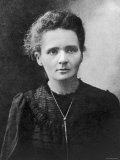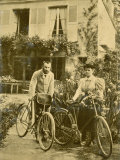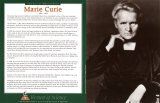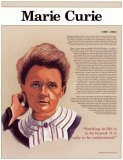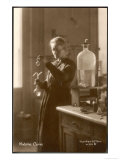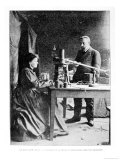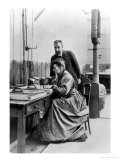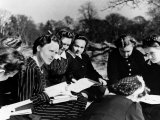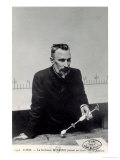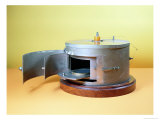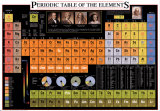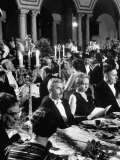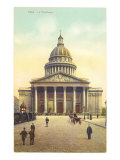|
Marie Curie
b. 11-7-1867; Warsaw, Poland
d. 7-4-1934: France
Marie Curie, with her husband Pierre, experimented and discovered many cutting edge technologies at the beginning of the 20th Century.
She was born Maria Sklodowska, the fifth child of teachers Bronislawa and Vladislav Sklodowska in Warsaw, Poland. Her family called her Manya.
Manya was a very good student. She found science and mathematics fun and graduated top of her class. Because women were not permitted to get advanced degrees at the time she, sister Bronya, and her friends attended an illegal school. It was called the Floating University because it met in different locations so the authorities wouldn’t find out about it.
After much planning and hard work Manya and Bronya were able to study in Paris. It was in Paris that Maria/Manya became Marie.
Marie studied very hard at the Sorbonne and earned Master’s degrees in both physics and math. Then in 1894 when she was searching for laboratory space she met Pierre Curie. They found in each other the perfect companion and married in July, 1895.
Pierre and Marie had two daughters, Irene and Eve, and Marie was a working mother. She earned certificates that allowed her to teach girls, worked on advanced degrees and began the experiments with her husband that would lead her to be awarded two Nobel prizes; one for Physics and one for Chemistry.
Pierre Curie was in failing health, as was Marie, from the prolonged exposure to the radioactive elements they were working with. No one knew of the dangers at the time, if fact, the Curie’s coined the word radioactive to describe what they were discovering. Pierre died in April, 1906, not from radiation poisoning but in an accident, being run over by a horse drawn wagon as he was crossing a street during rainy weather.
After Pierre’s death Marie Curie took over her husband's new academic post at the Sorbonne, the first woman professor there. From this position she created a state-of-the-art lab and a scientific institution. All of this took much of Marie’ s attention but she made time to teach at her daughter’s cooperative school. The school had been set up by a group of parents who each agreed to teach the children from their area of professional expertise- history, science, math, studio art and literature.
| • “Life is not easy for any of us. But what of that? We must have perseverance and above all confidence in ourselves. We must believe that we are gifted for something and that this thing must be attained.”
• “I am among those who think that science has great beauty. A scientist in his laboratory is not only a technician: he is also a child placed before natural phenomena which impress him like a fairy tale.”
• MARIE CURIE POSTERS
|
Marie Curie,
Women of Science
Poster Text: The pioneering reasearch of physicist and chemist Marie Curie contributed to some of the most important new fields of study in science, from modern physics to the treatment of cancer. Madame Curie was the first woman to be awarded a Nobel Prize, the most famous honor in science. Eventually she won two Nobels.
On November 7, 1867, Marya Sklodowska was born in Warsaw, Poland. Her father, a professor of mathematics and physics, sparked her interest in science. After graduating from high school, she began working as a tutor and governess to earn money so she could fulfill her dream of attending the Sorbonne, a university in Paris.
In 1891 she moved to France and began studying at the Sorbonne, registering as Marie, the French version of her name. In just two years she earned a degree in physics, and went on to earn a second degree in mathematics in another year. She met Pierre Curie, a well-known and respected physicist, in 1894, and they married the following year.
Another French physicist, Antoine Bacquerel had recently discovered that a metal called uranium let off rays of energy that no one understood. Madame Curie decided to study these rays. Her research soon revealed that this energy which she named “radioactivity,” came from within the atom itself. An atom is the smallest particle of a simple chemical substance called an element. In 1898 her husband joind her in this research, and working with tons of uranium ore, they separated out two new radioactive elements. They named these elements polonium, after Madame Curie's native Poland, and radium.
In 1906, Pierre Curie was hit by a truck and killed. Madame Curie took up his professorship at the Sorbonne becoming the first woman ever to teach there. She carried on her research of radium, and in 1911 she was awarded the Nobel Prize in Chemistry for separating out radium and studying its chemical properties. Madame Curie helped found the Radium Institute in Paris in 1914 and served as its first director. This center, where doctors use radiation to treat cancer and researchers study chemistry and biology, was later renamed the Curie Institute.
Radium can be used to take an x-ray. After the outbreak of World War I, Madame Curie helped set up x-ray machines in vans that could be taken out to help doctors treat the wounded.
Although no one knew it at that time, radiation can make people very ill. Both Pierre and Marie Curie sufferd bad health effects from what is now known as radiation sickness. On July 4, 1934, Marie Curie died of leukemia, most likely brought on by exposure to radiation during her work. Her daugher, Irene Joliot-Curie, and her son-in-law continued research in the same field, and the two of them were awared the Nobel Prize in Chemistry in 1935 for producing new radioactive elements.
• more Women of Science posters
|
|
|
|
Marie Curie, Hero of the 20th Century-
“Nothing in life is to feared.
It is only to be understood.”
• more Heroes of the 20th Century posters
|
|
|
Poster Text: “We must have perseverance and above all confidence in ourselves. We must believe that we are gifted for something and that this thing must be attained.” -Marie Sklodowska Curie
A truly remarkable woman, Marie Curie is best known as the discoverer of the radioactive elements polonium and radium and as the first person to win two Nobel Prizes. Her work has affected the lives of people everywhere through the application of radioactive principles in medicine, communications, and in industrial technology.
• more Heroes of Science & Technology posters
• Famous Teachers posters
|
|
|
|
|
|
|
|
Women of Science
Composite Poster
• who is in this poster?
|
|
|
|
|
|
|
|
|
|
|
Ionisation Chamber Devised by Marie Curie c. 1897
Ionization is the physical process of converting an atom or molecule into an ion by adding or removing charged particles such as electrons or other ions.
|
|
|
Periodic Table of the
Elements
Poster has Symbol, Name, Atomic Number, Atomic Weight, State of matter, short bios - John Dalton, Amedeo Avogadro, Mendeleev, Marie Sklodowska Curie, Albert Einstein
• chemistry posters
|
|
|
The Atom Poster,
English Edition
|
|
|
The Atomic Bomb
Inventions that Changed
the World -
At 8:16 in the morning, August 6, 1945, in a blinding flash of light, the world changed forever. Humankind entered a new era, symbolized by a mushroom-shaped cloud rising seven miles into the air over the city of Hiroshima, Japan. The Atomic Age had begun. ...
• more Inventions posters
• World War II Posters
|
|
|
Eve Curie Labouisse
b. 12-6-1904; Paris
d. 10-22-2007; New York
Eve Curie was Pierre and Marie Curie's second daughter. Eve, who became a concert pianist and writer; her husband Henry Richardson Labouisse, Jr. accepted the 1965 Nobel Peace Prize of behalf of UNICEF.
|
|
|
|
|
|
Pantheon, Paris, France
• more architecture posters
|
|
Marie continued to experiment, work- she and her daughter Irene set up and ran the mobile x-ray units for the French Army in WW I, and travel. She became one of the most recognized people on the Earth, the press was always around looking for a scandal or controversy. Marie Curie came to distrust the press.
Marie Curie died at age 66 on July 4, 1934 from “aplastic pernicious anemia...by long accumulation to radiations.” She was buried beside Pierre in a family plot. Sixty years later they were reburied in France’s national mausoleum, the Pantheon, in Paris.
Other notable expatriate Poles were Joseph Conrad, Frederic Chopin, and Guillaume Apollinaire.
Selection of educational posters celebrating chemist and physicist Marie Curie include posters from the Women in Science, Heroes of the 20th Century, Heroes of Science and Technology poster series and the Women in Science composite poster; related posters include the Periodic Table of Elements and Atomic Bomb: Inventions that Changed the World.
Read more about Marie Curie.
Marie Curie: A Life by Susan Quinn - brilliant well-rounded, in-depth view of Curie as a scientist, a woman, a wife and a lover. 16 pages of photos; notes; index.
Marie Curie and the Discovery of Radium (Barrons Solution Series) - by Ann E. Steinke - ages 9-12.
Marie Curie: More Than Meets the Eye (2000) VHS -Fictionalized presentation of Marie Curie’s life.
The Quotable Scientist Words of Wisdom from Charles Darwin, Albert Einstein, Richard Feynman, Galileo, Marie Curie, Rene Descartes, and more
by Leslie Alan Horvitz (Editor) - Challenging, controversial, and frequently eloquent musings from an impressive, ‘all-history’ lineup of groundbreaking scientists and philosophers. Those who refuse to go beyond fact rarely go as far as fact. -Thomas Henry Huxley
LINKS FOR LEARNING: MARIE CURIE
FYI - Marie Curie is one of many Poles who left Poland during the "Great Emigration” when political and educational opportunities were limited or denied; other notable expatriate Poles were Frederic Chopin (1810-1849) Joseph Conrad (1857-1924), and Guillaume Apollinaire (1880-1918).
Did you know that one of physicist Chien-Shiung Wu honorific nicknames was the Chinese Marie Curie?
|





